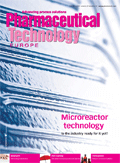MRT coming soon to a plant near you
Well, the summer's well and truly behind us and Madrid beckons for this year's CPhI Worldwide.
Well, the summer's well and truly behind us and Madrid beckons for this year's CPhI Worldwide. I am looking forward to my October visit to the Spanish capital, not only for the fine weather, fresh tapas and good wine of course, but because this will be my first visit to the world's largest exhibition on pharmaceutical ingredients. Not only do we attend these events to keep updated on cutting edge technologies and processes as well as the latest developments in your industry, but they provide the ideal forum for us to gain feedback from our readers first hand. As always, the Pharmaceutical Technology Europe (PTE) team will be exhibiting at the event (stand 6G42) so please do stop by to say hello and to let us know what you think of your PTE. We look forward to meeting you there.

Fedra Pavlou
In this month's issue of PTE, we investigate the role of microreactor technology (MRT) in the continuous, commercial scale production of pharmaceuticals. This really is a fascinating technology and, although its use in the pharma industry has been largely limited to small-scale, laboratory settings, we fully believe that we will be hearing a lot more about MRT over the coming years. In fact, not only are some of the big names in pharma already endorsing it (GlaxoSmithKline being one of the first to use MRT for multi kg-scale projects some 4–5 years ago) but, according to the experts that we spoke with this month, many of the pharma giants are now investigating the feasibility of the technology for some of their new projects. Lack of data, knowledge and perhaps confidence, as well as the relative immaturity of the technology in this setting have deterred widespread uptake so far; however, even the FDA has encouraged manufacturers to seek alternative manufacturing methods. The US agency has emphasised the benefits of continuous processing to improve efficiency, manage variability, reduce waste and reduce the incidence of the scale-up problems associated with batch manufacturing. So, as the curtain of confidentiality is lifted and more data is published touting the benefits of MRT in commercial scale pharmaceutical production, confidence in the technology is sure to grow and widespread uptake will inevitably follow.
Turning our attention online, I'm hoping that by now you will have had the opportunity to take a look at our brand new website, www.pharmtech.com. We do hope that you find it useful but, as always, I would welcome your thoughts on it, so please do feel free to email me. Our LinkedIn group is another way of keeping in touch with us so do take this as an invitation to join and connect with our growing group of experts by visiting www.pharmtech.com/linkedin.

Best wishes,
Fedra Pavlou, Editor-in-Chief

Drug Solutions Podcast: A Closer Look at mRNA in Oncology and Vaccines
April 30th 2024In this episode fo the Drug Solutions Podcast, etherna’s vice-president of Technology and Innovation, Stefaan De Koker, discusses the merits and challenges of using mRNA as the foundation for therapeutics in oncology as well as for vaccines.
Drug Solutions Podcast: Gliding Through the Ins and Outs of the Pharma Supply Chain
November 14th 2023In this episode of the Drug Solutions podcast, Jill Murphy, former editor, speaks with Bourji Mourad, partnership director at ThermoSafe, about the supply chain in the pharmaceutical industry, specifically related to packaging, pharma air freight, and the pressure on suppliers with post-COVID-19 changes on delivery.
PacBio Chosen as Tech Partner for Global Alzheimer’s Disease Research Project
April 23rd 2025The project, the North African Dementia Registry, will unite multiple entities for the purpose of developing a comprehensive dataset to advance the research community’s understanding of Alzheimer’s disease and other dementias in diverse populations.